Phone anxiety and constant admin: Why ‘Do Not Disturb’ is the latest loved feature for Gen Z
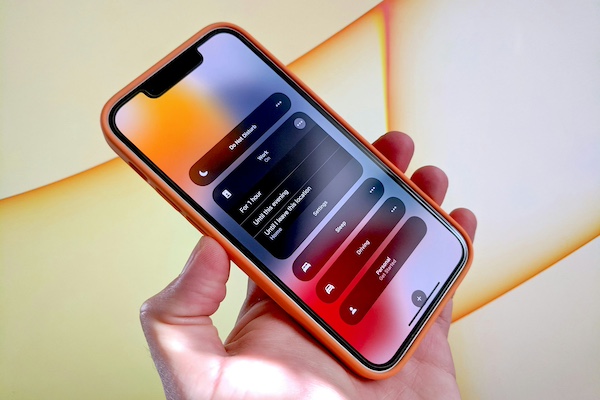
There’s no argument that phones have given us incredible opportunities for communication and digital socialisation. You can talk to anyone—at any place, at any time. But such advancements in technology have brought with them a weight of responsibility that we underestimated, and, for young people in particular, the obligation to stay connected and be constantly contactable is proving just too much.
It’s becoming widespread knowledge that Gen Zs favour their phone's “Do Not Disturb” feature, which mutes sound, prevents vibrations, and blocks visual banners and notifications. And why? Well, it’s all about curbing anxiety, lessening expectations and reducing the constant stream of contact and disruption that accompanies modern phone use.
With Gen Zs setting aside time in their evenings for ‘phone admin’ to manage the endless stream of notifications, we set out to find out the true scale of this issue, deep-diving into the data to see which apps were the worst culprits for phone anxiety.
We completed a study among different generations—Gen Z, millennials, and Gen X—and analysed the number of notifications they received both daily and weekly. Following this, we assessed which apps were key culprits for an anxiety-inducing number of notifications and which apps we were putting off opening as a result.
Daily notifications
The study found that the average person receives 146 daily notifications (nearly 1020 a week!) or one every 10 minutes. However, it was clear that one generation was more affected than others.
Gen Zs and millennials receive more than twice the number of notifications as their Gen X parents.
musicMagpie found that Gen Zs receive around 55% more alerts than their parents, with an average of 181 daily notifications. This equates to one notification every 8 minutes!
On average, millennials received around 5% fewer notifications, with 172 daily notifications. Finally, Gen X receive around 84 notifications per day.
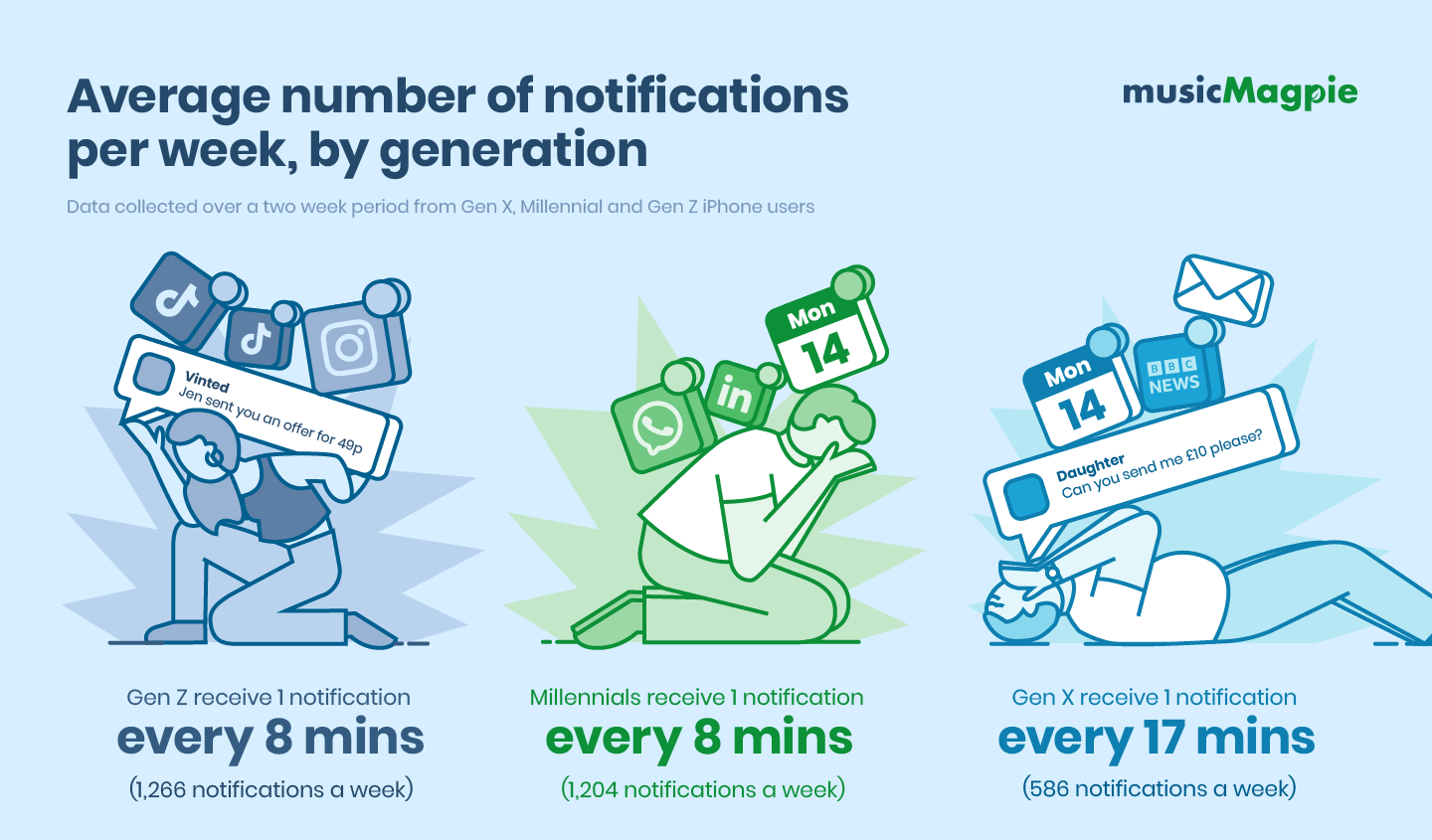
The best and worst days for notifications
musicMagpie data showed that there are better and worse days when it comes to being overwhelmed by notifications, and these days differed per generation.
Thursday is the worst for phone anxiety for both Gen Zs and Millennials
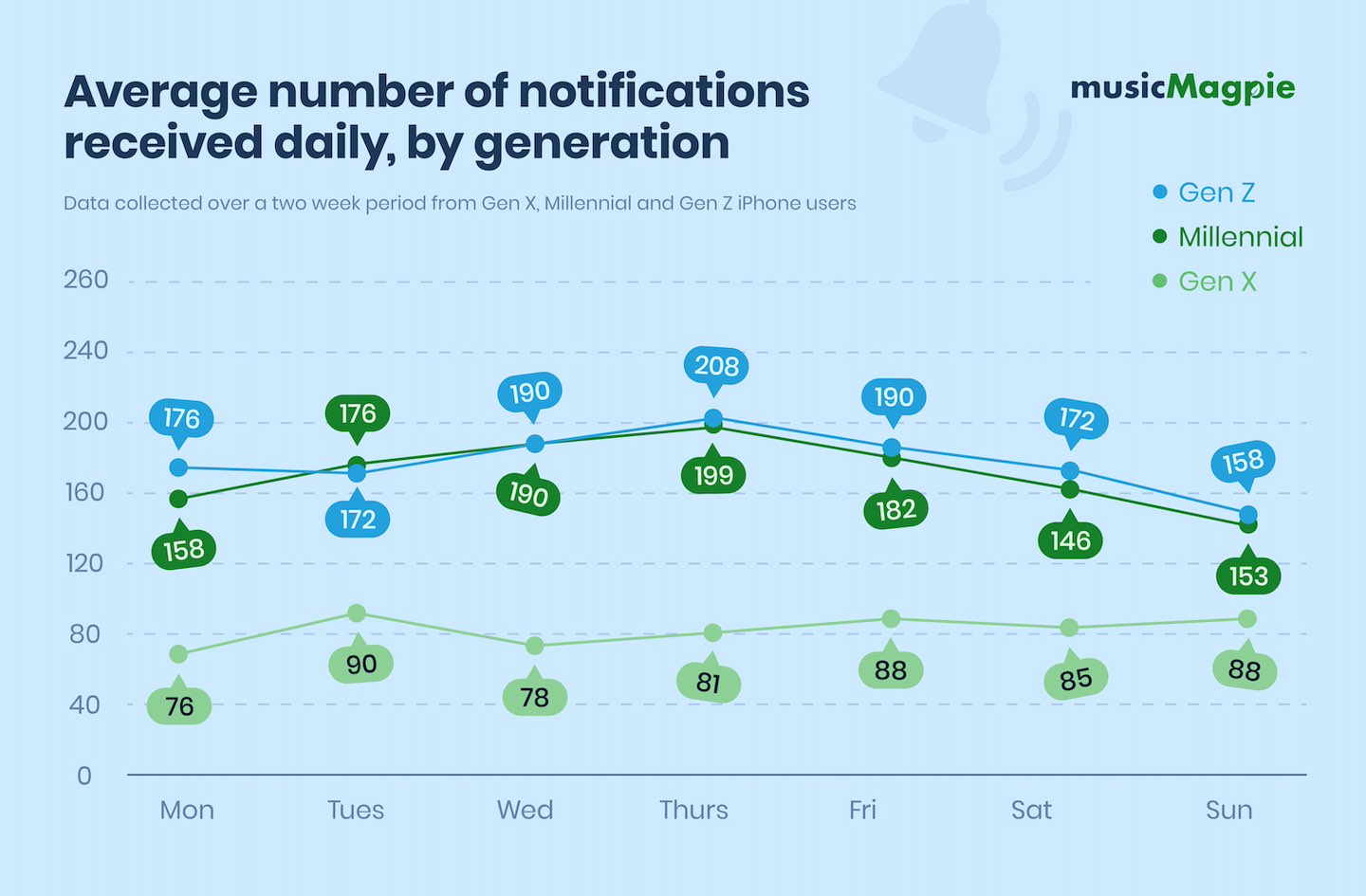
Thursdays were likely to be the most overwhelming and anxiety-inducing day for Gen Zs to be on their phones. On average, Gen Zs received a staggering 208 notifications on a Thursday (that’s around 17 per waking hour).
Sunday is your best bet for a text back from a Gen Z
Data from one Gen Z participant shows that they receive an average of 479 notifications on Thursday (that’s nearly 20 notifications an hour!). Gen Z’s least anxiety-inducing day was Sunday, with an average of 158 notifications received. So, if you want a quick reply from a Gen Z, Sunday is your best bet for a text back.
Millennials were close to Gen Z’s tails, also having stressful Thursdays with an average of 199 notifications received. However, surprisingly, millennials' quietest day was a Saturday, with 146 notifications coming through.
Finally, data from Gen X showed a significantly lower number of notifications coming through. The peak of action was on Tuesday, with 90 notifications (around 7 or 8 a waking hour), and their calmest day was Monday, with only 76.
Which apps cause the most phone anxiety?
The study pulled each participant's top three worst apps for notifications to find the most common offenders, and there were certainly some clear winners.
WhatsApp consistently topped the list, sending the most alerts to over half of the participants, followed by iMessage, Instagram, Messenger, and Gmail.
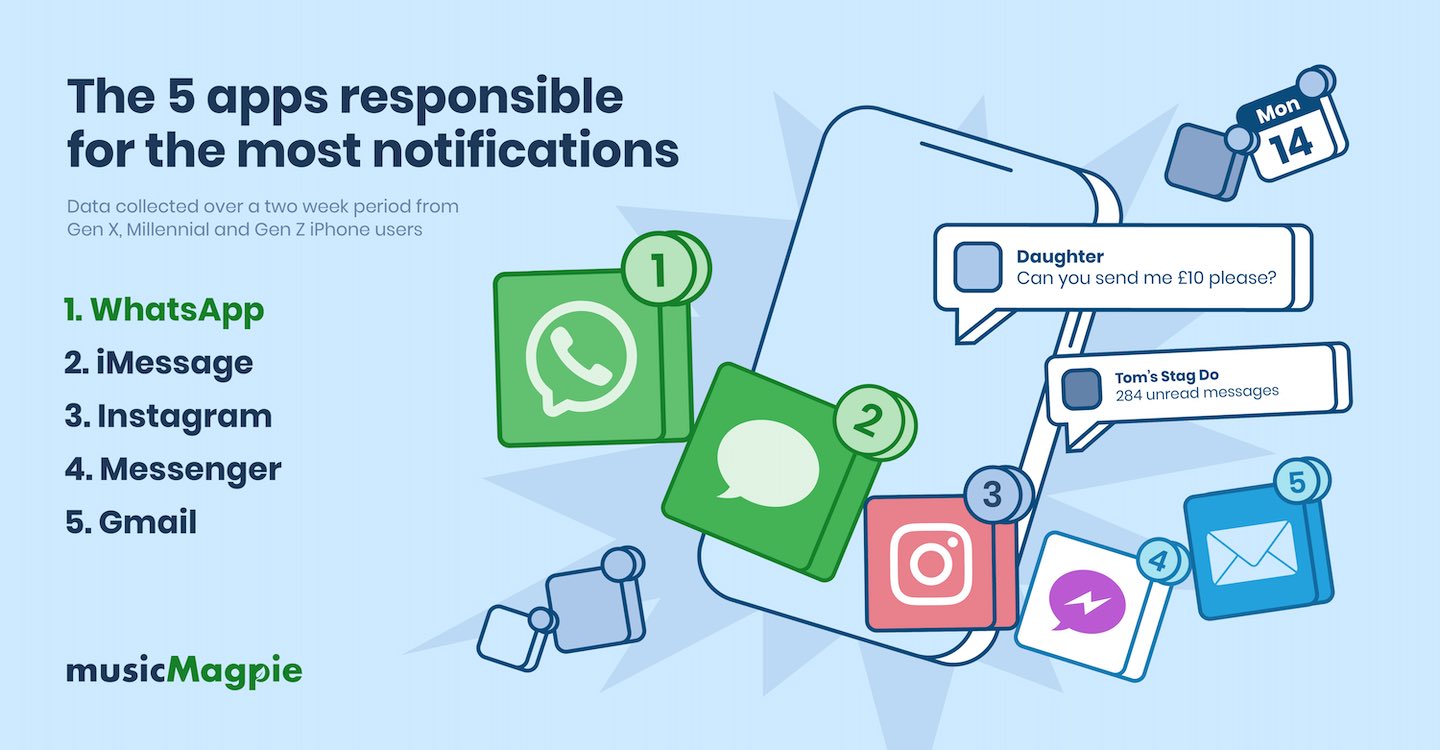
Again, there were some key generational differences.
iMessage was the top notifier for Gen Z, followed by WhatsApp, Instagram, and Mail. Spotify and The Independent newspaper were also top notifiers on Gen Z’s list, making them the most musical and well-read generation in the study.
WhatsApp was the top notifier for Millennials, followed by Messenger, Mail, Instagram and Snapchat. However, it was evident that Millennials have kept to their work-driven pet parent roots, with Petcube, a pet camera app, and Slack, a business messaging app, making it into the list of their top notifiers.
Finally, the top-ranking notifiers for Gen X were WhatsApp and iMessage, followed by BBC News, Home, and Nest. The Ring Doorbell app also appeared as a top offender, as did Duolingo, a language education app, demonstrating Gen X's passion for both learning languages and home security.
Anxiety at first sight: the apps with the most unread notifications
Keeping up with phone admin in a fast-paced, mobile-oriented society can be hard. Most of us are no strangers to the stress of the growing and uncontrollable red notification circles dominating our home screens.
To get a snapshot of the average daily home screen, we asked participants to submit the number of unopened notifications on their home screens at the time of the study and name and shame the apps responsible for a distressing number of red alerts. The phone home screens we looked into were chaotic, to say the least.
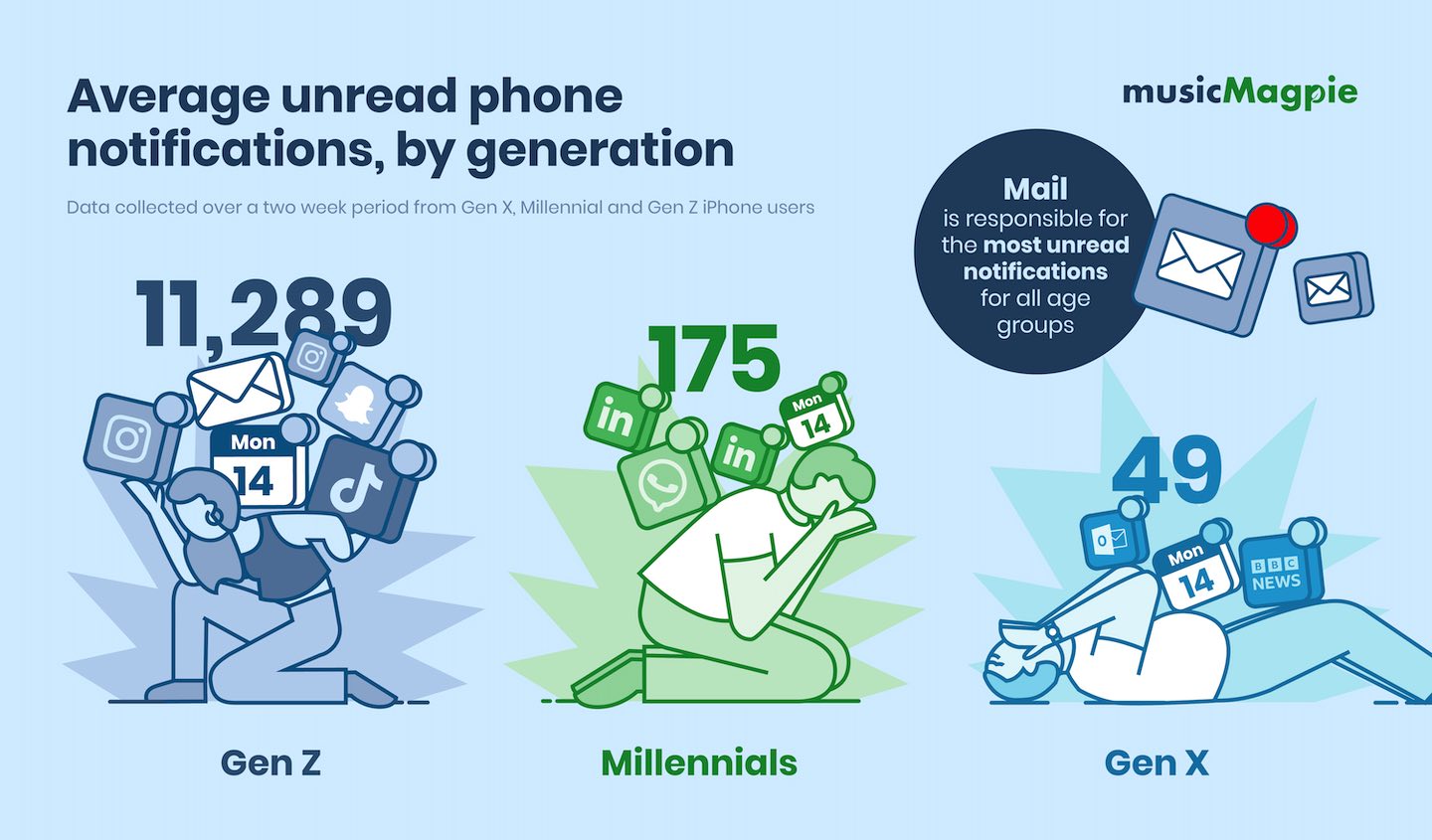
On average, Gen Zs had 11,289 unread app notifications on their phones, followed by Millenials with 175 and Gen Xs with an average of 49.
Perhaps unsurprisingly, the mail app was the top dog of unopened alerts on average. Particularly for Gen Zs, mail apps have gotten out of hand, with one phone user, aged 24, having a total of 98,334 unopened emails at the time of the study (we can only imagine how much it’s gone up since then). Gen Zs also stopped opening notifications on apps like iMessage, Vinted, Pinterest, and Snapchat.
On millennials’ phones, in addition to mailing apps, they also received alerts from Facebook, LinkedIn, and YouTube.
Finally, red banners appeared on Gen X’s phones for apps like Mail, Google Photo, Reddit, Facebook, and Messenger. Surprisingly, only one Gen X participant had unread notifications from WhatsApp despite being their generation's top notifier (Gen Xs seem pretty nifty with their phone admin and certainly not as overwhelmed as Gen Zs).
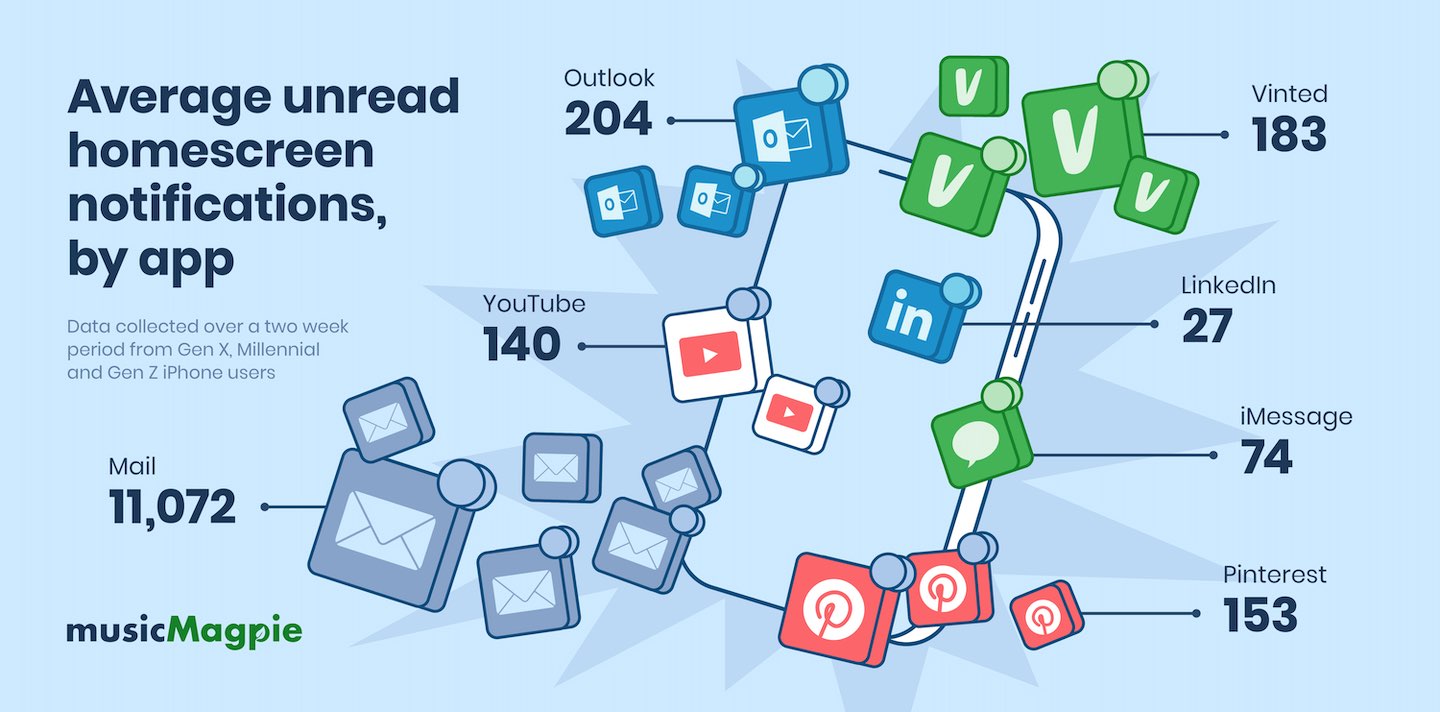
With the constant flow of notifications comes a growing sense of responsibility, and we get it, Gen Z. Sometimes enough really is enough.
Methodology
musicMagie conducted a small study analysing the iPhone notification data from 30 participants for two weeks: 10 Gen Z, 10 Millennials and 10 Gen Xs. This data can be found on the settings app on every iPhone. The averages used are based on the mean average of both daily and weekly sums.
The apps that caused the most notifications were determined by collecting the worst three apps for notifications for each participant and counting the number of times they appeared in the top three lists across the study.
Unread home screen notifications were taken as a snapshot of their current phone at the time of the study and averaged.

